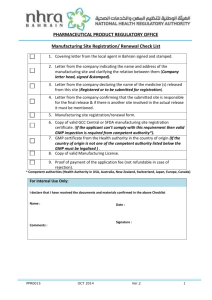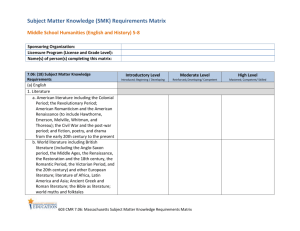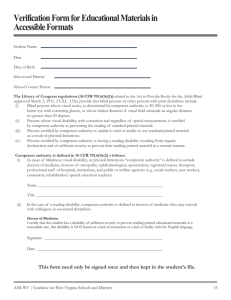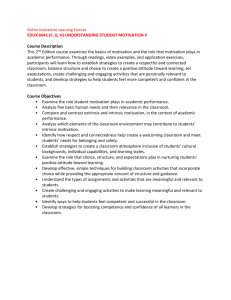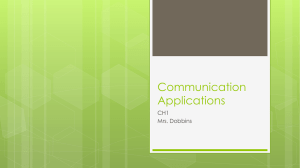DRAFT FOR CONSULTATION THE UNIVERSITY OF MELBOURNE
advertisement
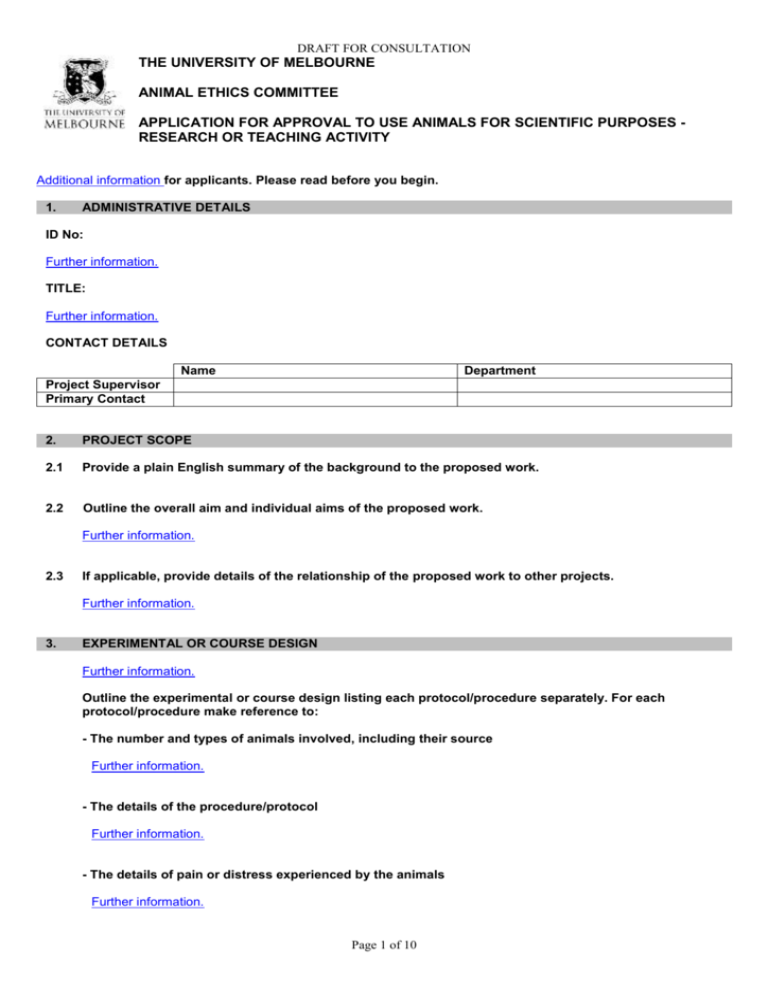
DRAFT FOR CONSULTATION THE UNIVERSITY OF MELBOURNE ANIMAL ETHICS COMMITTEE APPLICATION FOR APPROVAL TO USE ANIMALS FOR SCIENTIFIC PURPOSES RESEARCH OR TEACHING ACTIVITY Additional information for applicants. Please read before you begin. 1. ADMINISTRATIVE DETAILS ID No: Further information. TITLE: Further information. CONTACT DETAILS Name Department Project Supervisor Primary Contact 2. PROJECT SCOPE 2.1 Provide a plain English summary of the background to the proposed work. 2.2 Outline the overall aim and individual aims of the proposed work. Further information. 2.3 If applicable, provide details of the relationship of the proposed work to other projects. Further information. 3. EXPERIMENTAL OR COURSE DESIGN Further information. Outline the experimental or course design listing each protocol/procedure separately. For each protocol/procedure make reference to: - The number and types of animals involved, including their source Further information. - The details of the procedure/protocol Further information. - The details of pain or distress experienced by the animals Further information. Page 1 of 10 DRAFT FOR CONSULTATION - The details of monitoring Further information. - The fate of the animals Further information. 4. INVESTIGATORS AND COMPETENCY Please identify individual investigators, their competencies and if applicable trainers for each of the protocols/procedures listed in Question 3 ‘Experimental or Course Design’. Further information. Procedure x Name Institution / Department Competency Training / Competent Training / Competent Training / Competent Training / Competent Training / Competent Trainer Institution / Department Competency Training / Competent Training / Competent Training / Competent Training / Competent Training / Competent Trainer Institution / Department Competency Training / Competent Training / Competent Training / Competent Training / Competent Training / Competent Trainer Procedure y Name Procedure z Name 5. HOUSING OF ANIMALS 5.1 For each species/strain requested, complete a row in the table. Species / Strain Location Housing Standard / Other Standard / Other Standard / Other Standard / Other Standard / Other Page 2 of 10 Grouping Individual / Grouped Individual / Grouped Individual / Grouped Individual / Grouped Individual / Grouped 5.2 DRAFT FOR CONSULTATION If relevant, provide further details of housing, including, as relevant, details of outdoor housing, any special housing requirements, details of enrichment etc.: Further information. 6. REPLACEMENT Further information. 6.1 Explain why it is necessary to use animals for this research or teaching activity. 6.2 What alternatives to animal use have been considered? 6.3 Provide justification for the choice of animal/s, including justification for: - species/strain Further information. - sex - age 7. REDUCTION Further information. 7.1 Provide statistical or other justification for the number of animals requested. Break down the total number by procedures, treatments, repeats, groups, etc… Further information. 7.2 Have the animals been used in another project? If yes, outline the cumulative burden and provide justification for re-use. Further information. 8. REFINEMENT What steps have been taken to support and safeguard animal welfare? How has the impact on the animals been minimised? Further information. 9. OVERALL JUSTIFICATION Explain how the potential effects on the wellbeing of animals in this project are justified by the potential benefits of the proposed work. Further information. Page 3 of 10 DRAFT FOR CONSULTATION 10. GLOSSARY Scientific Term 11. Title Lay Description ATTACHMENTS Description Page 4 of 10 DRAFT FOR CONSULTATION THE UNIVERSITY OF MELBOURNE ANIMAL ETHICS COMMITTEE APPLICATION FOR APPROVAL TO USE ANIMALS FOR SCIENTIFIC PURPOSES ADDITIONAL INFORMTION SHEET Before Completing an application, applicants should familiarise themselves with all relevant guidelines and legislation, including the NHMRC (2013) Australian Code for the Care and Use of Animals for Scientific Purposes. To ensure that all AEC members are provided with sufficient information to participate effectively in the assessment of the application, all responses must be given in plain English. NB: Additional justification is required for activities that involve: (a) severe compromise to animal wellbeing, and for which Replacement, Reduction and Refinement (the 3Rs) cannot be fully applied for the project to proceed, including: - unrelieved pain and distress, including where the planned endpoints will allow severe adverse effects to occur (see Clauses 1.12 and 3.1.18–3.1.19 of The Code) - death as the endpoint (see Clause 1.13 of The Code) - reuse and repeated use of animals (see Clauses 1.22–1.24 and 2.3.15 of The Code) - prolonged restraint or confinement (see Clause 3.3.4 of The Code) (b) use of non-human primates If planning to undertake a project that involves any of the above, it is best to consult an animal ethics administrator before beginning your application. Back to application. 1. PROJECT TITLE AND CONTACT DETAILS ID No: Provide the unique identification number assigned by THEMIS when the application was created. Back to application. TITLE: The title should give a clear, concise indication of the work proposed. Back to application. CONTACT DETAILS Name Department Project Supervisor Primary Contact 2. PROJECT SCOPE 2.1 Provide a plain English summary of the background to the proposed work. Page 5 of 10 DRAFT FOR CONSULTATION 2.2 Outline the aims of the proposed work. Outline the overall aim of the proposed work as well as individual aims. Back to application. 2.3 Provide details of the relationship of the proposed work to other projects. Include, as relevant, application ID numbers. Back to application. 3. EXPERIMENTAL OR COURSE DESIGN This section is where you provide the details of your proposed research or teaching activity. It must contain enough detail that a proper assessment of the impacts of the protocols/procedures on each animal (or group of animals) can be made. Information should be presented in a logical sequence. Information should be structured under headings and subheadings as appropriate. Include graphs, tables, timelines and diagrams as necessary. Back to application. Outline the experimental design listing each protocol/procedure separately. For each protocol/procedure make reference to: - The number and types of animals involved, including their source If using genetically modified animals, describe the genetic modification, its relevance to the work, and any associated welfare concerns. Back to application. - The details of the procedure Provide a clear timeline of events, including the duration of, and between, procedures. Provide, as relevant, details of capture of animals. Provide, as relevant, details of transport of animals. Provide, as relevant, doses of all agents (e.g. drug, analgesics, anaesthetics in mg/kg), delivery routes, volumes of blood collections. Provide details of the location/s where procedures will be performed. Clearly outline what will be done to the animals. Back to application. - The details of pain or distress experienced by the animals Provide an assessment of the potential adverse impacts on animal wellbeing for the duration of the project. Page 6 of 10 DRAFT FOR CONSULTATION Include, as relevant, an assessment of cumulative burden. Back to application. - The details of monitoring Explain how the wellbeing of animals will be monitored and assessed throughout the project. Outline the frequency of monitoring and assessment, the actions to be taken if problems are identified, and the criteria for intervention points and humane endpoints. Make reference, as relevant, to attached monitoring and intervention criteria sheets. Back to application. - The fate of the animals Clearly outline what will happen to the animals at the end of the project. The planned endpoint of the project must be as early as feasible to avoid or minimise pain and distress to the animals Provide, as relevant, details of re-use and/or re-homing. Provide, as relevant, the details of killing of animals. Back to application. 4. INVESTIGATORS AND COMPETENCY For each of the protocols/procedures listed in Question 3, complete a table. If related, and where the details of competency and training are the same, multiple procedures may be combined in the one table (e.g. IV injection, IP injection, IM injection, etc.…). Back to application. Procedure x Name Institution / Department Competency Training / Competent Training / Competent Training / Competent Training / Competent Training / Competent Trainer Institution / Department Competency Training / Competent Training / Competent Training / Competent Training / Competent Training / Competent Trainer Institution / Department Competency Training / Competent Trainer Procedure y Name Procedure z Name Page 7 of 10 DRAFT FOR CONSULTATION Training / Competent Training / Competent Training / Competent Training / Competent 5. HOUSING OF ANIMALS 5.1 For each species/strain requested, complete a row in the table. Species / Strain 5.2 Location Housing Standard / Other Standard / Other Standard / Other Standard / Other Standard / Other Grouping Individual / Grouped Individual / Grouped Individual / Grouped Individual / Grouped Individual / Grouped If relevant, provide further details of housing, including: Failure to provide appropriate housing has clear impacts on the wellbeing of animals and potentially, on research quality. Provide details such that the AEC can be assured that the housing is appropriate and meets relevant guidelines or other requirements. Include, as relevant, details of outdoor housing. Include, as relevant, details of special housing requirements. Include, as relevant, details of environmental enrichment. Include, as relevant, justification for individual housing Back to application. 6. REPLACEMENT The unjustified use of animals is not ethical. Describe why animals are needed for this activity and provide evidence for the consideration of alternatives. Back to application. 6.1 Explain why it is necessary to use animals for this research or teaching activity. 6.2 What alternatives to animal use have been considered? 6.3 Provide justification for the choice of animal/s, including justification for: - species/strain Include, as relevant, justification/relevance of genetic modification. Back to application. - sex - age Page 8 of 10 DRAFT FOR CONSULTATION 7. REDUCTION Applicants must demonstrate that the minimum number of animals required to attain meaningful or statistically significant results will be used. Back to application. 7.1 Provide statistical or other justification for the number of animals requested. Break down the total number by procedures, treatments, repeats, groups, etc… Animal numbers and calculations should be presented clearly and logically. Include tables as necessary. The use of too few animals may invalidate results and result in the wastage of animals. Back to application. 7.2 Have the animals been used in another project? If so, outline the cumulative burden and provide justification for re-use. Include, as relevant, application ID numbers. To reduce animal use, could the animals or their tissues be used in another project upon completion of the proposed work? Back to application. 8. REFINEMENT What steps have been taken to support and safeguard animal welfare? How has the impact on the animals been minimised? Describe, as relevant, how protocols have been changed since this work was last conducted to minimise the impact on animals. Back to application. 9. OVERALL JUSTIFICATION Explain how the potential effects on the wellbeing of animals in this project are justified by the potential benefits of the proposed work. A research or teaching activity that uses animals is considered ethical where the potential benefits outweigh the impacts on the animals. Use this question to describe why the impacts are reasonable given the potential benefits. Respect for animals must underpin all decisions and actions involving the care and use of animals for scientific purposes. This respect is demonstrated by: (i) using animals only when it is justified (ii) supporting the wellbeing of the animals involved (iii) avoiding or minimising harm, including pain and distress, to those animals (iv) applying high standards of scientific integrity (v) applying Replacement, Reduction and Refinement (the 3Rs) at all stages of animal care and use: (a) the Replacement of animals with other methods (b) the Reduction in the number of animals used (c) the Refinement of techniques used to minimise the adverse impact on animals (vi) knowing and accepting one’s responsibilities. Page 9 of 10 DRAFT FOR CONSULTATION A judgement as to whether the proposed use of animals is ethically acceptable must be based on information that demonstrates the principles above, and must balance whether the potential effects on the wellbeing of the animals involved is justified by the potential benefits. Back to application. 10. GLOSSARY Scientific Term 11. Title Lay Description ATTACHMENTS Description Page 10 of 10

